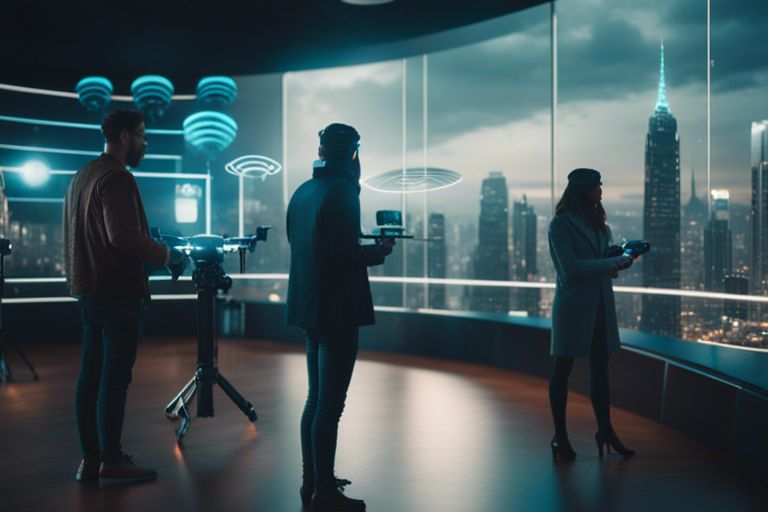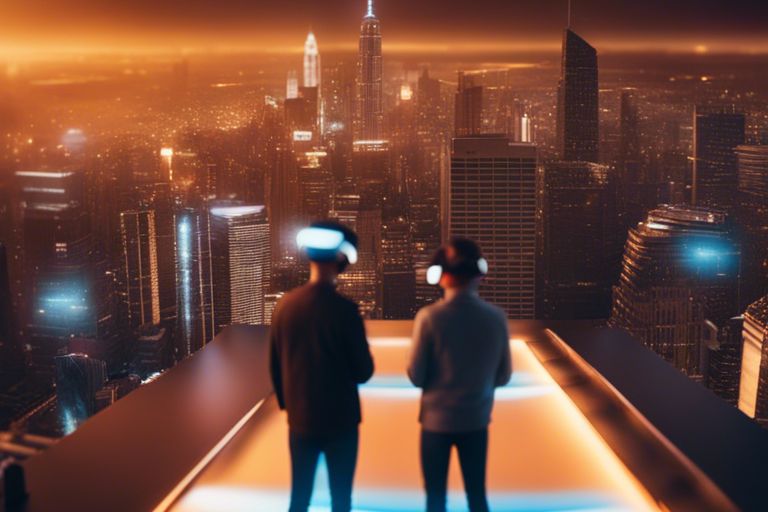Immersing Into The Future – Augmented And Virtual Reality In Emerging Technologies
Delve into the world of augmented and virtual reality, where the boundaries between the physical and digital realms are blurring like never before. These transformative technologies are revolutionizing industries, from healthcare to gaming, offering limitless possibilities for immersive experiences and groundbreaking innovations. However, as we leap into this futuristic landscape, it’s crucial to understand the potential risks and ethical implications that come with such powerful tools. Let’s navigate through the exciting developments and challenges of augmented and virtual reality in emerging technologies.
Augmented Reality in Emerging Technologies
Augmented Reality (AR) is a technology that superimposes a computer-generated image on the user’s view of the real world. It has found its way into various emerging technologies, transforming industries and experiences in innovative ways. AR provides a blend of digital information with the physical environment, opening up new possibilities for enhanced user experiences.
AR in Education and Training
Education and training have been revolutionized by the integration of AR technology. By overlaying digital content onto real-world objects, AR enhances learning experiences and improves knowledge retention. Students can interact with 3D models, explore virtual environments, and engage in simulations that bring complex concepts to life. This immersive learning approach not only makes education more engaging but also caters to different learning styles, making it a powerful tool for educators.
Training programs in various industries have also benefited from AR applications. From medical students practicing surgical procedures to engineers learning to operate complex machinery, AR provides a safe and realistic environment for hands-on training. AR simulations enable trainees to gain practical experience without the risks associated with real-world scenarios, ultimately enhancing their skills and confidence.
AR in Healthcare
Augmented Reality is making significant strides in the healthcare industry, revolutionizing patient care, medical training, and surgery. AR technology is being used to assist surgeons during procedures, offering real-time visual guidance and improving accuracy. Surgeons can overlay patient data, X-rays, and other vital information directly onto their field of view, providing valuable insights and enhancing surgical outcomes.
AR is also being utilized for medical training, allowing students to practice surgeries and medical procedures in a controlled and realistic environment. This hands-on approach enhances learning and skill development, paving the way for a new era of healthcare professionals.
Virtual Reality in Emerging Technologies
While augmented reality transforms the world around us, virtual reality (VR) immerses us in a completely digital experience. VR technology has rapidly evolved and is making a significant impact across various industries, ranging from entertainment and gaming to engineering and design.
VR in Entertainment and Gaming
Any discussion about virtual reality inevitably leads to its application in entertainment and gaming. The ability of VR to transport users to fantastical worlds and provide immersive gaming experiences is unparalleled. Gaming companies are continually pushing the boundaries of VR technology, creating lifelike environments and interactive gameplay that blur the lines between reality and fiction. From exploring alien landscapes to battling mythical creatures, the possibilities in VR gaming are endless.
VR headsets have become a common sight in the gaming world, allowing players to step into their favorite games like never before. The sense of presence and realism in VR gaming is unmatched, offering players a truly transformative experience that keeps them coming back for more. As VR technology continues to advance, we can expect even more groundbreaking developments in entertainment and gaming.
VR in Engineering and Design
Engineering and design industries have embraced virtual reality as a powerful tool for visualization, prototyping, and simulation. Virtual reality enables engineers and designers to create and interact with 3D models in a virtual space, allowing for better collaboration and design decisions. By immersing themselves in a virtual environment, professionals can gain new perspectives and identify potential flaws before committing to physical prototypes.
This technology is revolutionizing the way products are designed and developed, leading to more efficient processes and innovative solutions. Engineers and designers can now streamline their workflows, reduce costs, and accelerate the product development cycle by leveraging the capabilities of virtual reality. The integration of VR in engineering and design is paving the way for a more immersive and collaborative working environment.
The Intersection of AR and VR
Now, as we delve into the fascinating realm where augmented reality (AR) and virtual reality (VR) converge, we witness a landscape of possibilities that is reshaping the way we interact with technology.
Mixed Reality (MR) and its Applications
Mixed reality (MR) is where the physical and digital worlds co-exist and interact in real-time. This immersive technology blends elements of both AR and VR to create a user experience that is truly transformative. From gaming and entertainment to healthcare and education, MR has the potential to revolutionize various industries.
Applications
Plus, artificial intelligence (AI) plays a crucial role in enhancing the capabilities of AR and VR. Through machine learning algorithms and computer vision, AI enables these technologies to understand and respond to the environment in real-time, creating a more seamless and immersive experience for users.
Challenges and Considerations
Ethical Implications and Privacy Concerns
After diving into the world of augmented and virtual reality, it is crucial to address the ethical implications and privacy concerns that come hand in hand with these immersive technologies. One of the major concerns is the potential invasion of privacy as these technologies collect personal data and track user behavior in virtual environments. This raises issues regarding consent, data security, and the possibility of unauthorized access to sensitive information.
Furthermore, there are ethical dilemmas related to the use of augmented and virtual reality in certain industries, such as healthcare and education. The reliance on these technologies could lead to a lack of human interaction and empathy, potentially dehumanizing crucial aspects of these fields.
Technological Barriers and Accessibility
For addressing the technological barriers and accessibility issues in augmented and virtual reality, it is important to acknowledge the disparities that exist in terms of access to these technologies. Challenges such as high costs of devices, limited technical support for users with disabilities, and the lack of infrastructure in certain regions pose obstacles to widespread adoption.
Additionally, the complexity of developing and implementing augmented and virtual reality applications creates barriers for smaller organizations and developers who may not have the resources or expertise to navigate this rapidly evolving field.
Any oversight in addressing these challenges can result in exacerbating inequalities and limiting the potential benefits of augmented and virtual reality technologies for a diverse range of users.
The Future Landscape
Predictions for AR and VR Advancements
For the future of Augmented Reality (AR) and Virtual Reality (VR), experts predict a significant advancement in both technologies. AR is expected to become more integrated into our daily lives, overlaying digital information onto the physical world seamlessly, revolutionizing industries such as healthcare, education, and retail. VR, on the other hand, is anticipated to become more immersive and realistic, offering users an even more compelling and interactive experience. With advancements in hardware and software, we can expect AR and VR devices to become more compact, powerful, and affordable, opening up new possibilities for applications and experiences.
Integrating AR and VR into Daily Life
On the horizon of technology, the integration of AR and VR into our daily lives is set to transform how we work, play, and communicate. Imagine attending meetings in a virtual boardroom, exploring distant lands from the comfort of your living room, or trying out furniture in your home before making a purchase, all made possible through AR and VR technologies. As these technologies continue to evolve, they will blur the line between the physical and digital worlds, creating new opportunities for enhanced experiences and interactions.
Integrating AR and VR into daily life has the potential to revolutionize various industries, including healthcare, architecture, tourism, and entertainment. Healthcare professionals can use AR to visualize complex medical procedures, architects can overlay designs onto existing spaces for better visualization, tourists can embark on virtual guided tours, and gamers can immerse themselves in dynamic virtual worlds.

Summing up
In conclusion, the rise and rapid development of augmented and virtual reality technologies are transforming the way we interact with the world around us. These emerging technologies have immense potential to revolutionize various industries such as healthcare, education, entertainment, and more. As we immerse ourselves further into this digital future, it is crucial to stay informed and adapt to the changes that this technological evolution brings. Embracing augmented and virtual reality opens up endless possibilities for innovation and creativity, paving the way for a more immersive and engaging future.
FAQ
Q: What is augmented reality (AR) and virtual reality (VR)?
A: Augmented reality (AR) enhances the real world with digital elements, while virtual reality (VR) creates a completely immersive digital environment.
Q: How is AR and VR being used in emerging technologies?
A: AR and VR are being utilized in emerging technologies for various applications such as training simulations, interactive education, virtual tours, immersive gaming experiences, and enhancing marketing strategies.
Q: What are some key differences between AR and VR?
A: The main difference between AR and VR is that AR overlays digital information onto the real world, whereas VR creates a fully digital environment that users can interact with.
Q: How is AR and VR impacting industries such as healthcare and retail?
A: In the healthcare industry, AR and VR are used for surgical simulations, patient education, and therapy sessions. In retail, these technologies are being used for virtual try-on experiences, interactive product showcases, and personalized shopping recommendations.
Q: What are some challenges faced by AR and VR technologies?
A: Challenges include hardware limitations, user discomfort, lack of standards, content creation complexities, and data privacy concerns. However, continuous advancements in technology are addressing these challenges to improve the overall AR and VR experiences.
![]()












